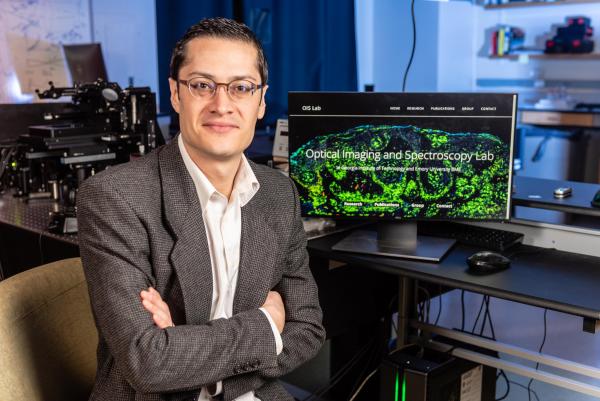Researchers in the lab of Francisco Robles are advancing optical technologies, bringing greater clarity and understanding to the biomolecular world. Their latest work improves the functionality and affordability of a powerful new imaging technique.
In recent years, three-dimensional refractive index (RI) tomography has emerged as an effective label-free imaging tool in biological studies. But, wrote Robles and colleague Patrick Ledwig, “its limitation to thin samples, resulting from a need of transmissive illumination, and small fields of view has hindered its utility in broader biomedical applications.”
They describe a new approach that enables RI tomography of arbitrarily thick samples with a large view in their paper, “Quantitative 3D Refractive Index Tomography of Opaque Samples in Epi-Mode,” published in the journal Optica.
“We’re enabling a technique that has previously been limited to thin samples,” said Robles, assistant professor in the Wallace H. Coulter Department of Biomedical Engineering.
The technology has been moving toward rendering more detailed 3D information, but it had been limited to individual cells.
“People have been trying to use the technique for various medical applications because you get these beautiful 3D tomographic images, but the fact that this was only possible on individual cells, and not at tissue-level structures, was really limiting,” Robles said.
Robles and Ledwig used a simple, low-cost microscope system with epi-illumination, which reflects light off the sample to create contrast. Existing techniques use transmissive illumination, which passes light through a sample. That works fine for translucent samples but not at all in thicker, more complex structures.
The approach they describe utilizes technology developed in the Robles lab — a quantitative oblique back illumination microscopy (qOBM) optical system — to extend the utility of 3D RI tomography for translational and clinical medicine.
“What we’re doing here is measuring the ubiquitous refractive and index properties in cells and tissues which yields unprecedented contrast for subcellular, cellular, and tissue-level structures,” Robles said.
He said the new approach allows researchers to perform label-free imaging, which is a non-invasive way to view a biological sample in its natural state. Many labs use chemical or fluorescent labels to track cellular activity. But the labeling process is invasive and can be toxic to cells, compromising research findings.
“This technique opens the door to many biomedical applications that were previously out of reach of refractive index tomography,” Robles said. “This will change the way in we do label-free imaging in complex 3D structures like human tissues, and enable new ways to extract biological information non-invasively.”
Robles described their solution as, “elegant and simple, providing near real-time information, without heavy computational processing. You don’t need an expensive laser — we actually used $8 LEDs for this system — and we can convert any basic brightfield microscope into this new tomographic imaging technology for a low cost.”
In their study, the researchers provide a theoretical analysis along with simulations and validation experiments using tissue-mimicking phantoms and thick tissue samples from animal and human brains. Their experiments showed a level of detail that Robles said isn’t possible with current, traditional optical methods.
“The level of cellular detail we are able to achieve now was only possible before with far more complex and expensive nonlinear microscopy systems which are not easily translatable to many important biomedical applications,” he said. “We’re very excited about the capabilities of this new refractive index tomography approach.”
This research was supported by the Burroughs Wellcome Fund (1014540); Marcus Center for Therapeutic Cell Characterization and Manufacturing; National Cancer Institute (R21CA223853); National Institute of Neurological Disorders and Stroke (R21NS117067); and the National Science Foundation (NSF CBET CAREER 1752011).
Media Contact
Keywords
Latest BME News
Jo honored for his impact on science and mentorship
The department rises to the top in biomedical engineering programs for undergraduate education.
Commercialization program in Coulter BME announces project teams who will receive support to get their research to market.
Courses in the Wallace H. Coulter Department of Biomedical Engineering are being reformatted to incorporate AI and machine learning so students are prepared for a data-driven biotech sector.
Influenced by her mother's journey in engineering, Sriya Surapaneni hopes to inspire other young women in the field.
Coulter BME Professor Earns Tenure, Eyes Future of Innovation in Health and Medicine
The grant will fund the development of cutting-edge technology that could detect colorectal cancer through a simple breath test
The surgical support device landed Coulter BME its 4th consecutive win for the College of Engineering competition.








